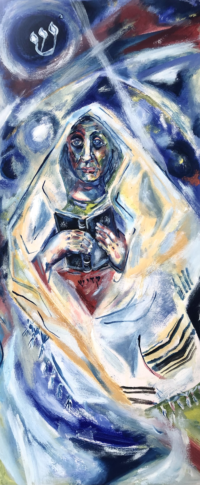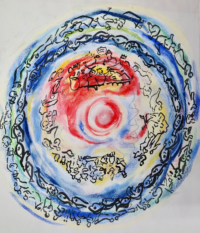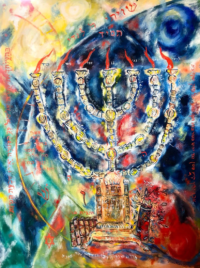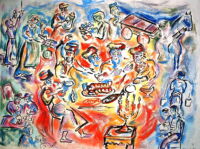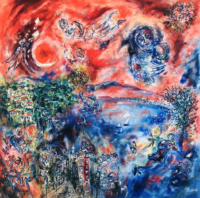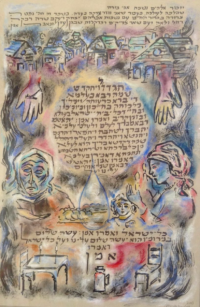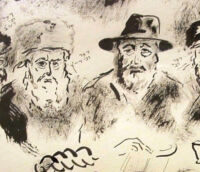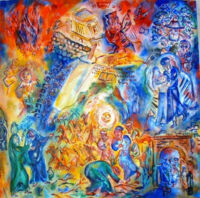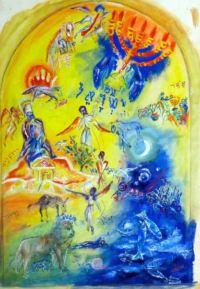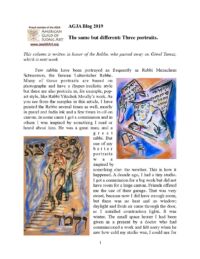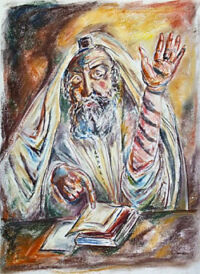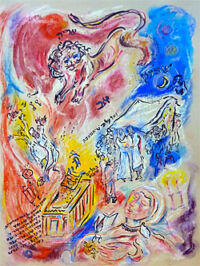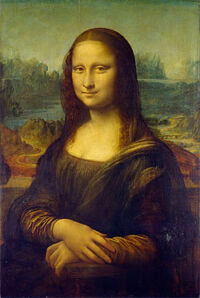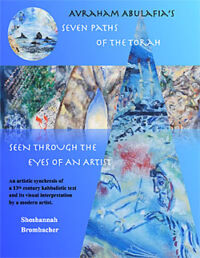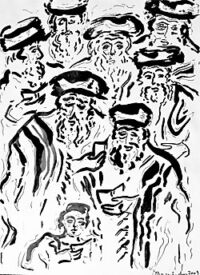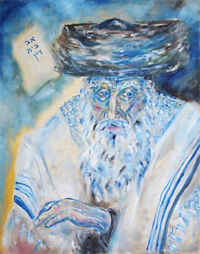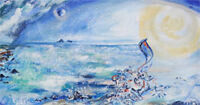AGJA Blog Archives
Kaddish has four letters
Painting is interpreting. Artists put thoughts and feelings on canvas the way they experience them or want to express them, their own or belonging to others, but seen though an artis’s lens. Here are my four canvasses about mourning and saying kaddish.
read more
Yosef and his brothers. Three artistic interpretations
It is not enough that an artist has good skills handling his our her tools, like brushes, chisels, a weaving-loom, clay, or whatever medium they work with, and it’s not enough that they are good at making compositions or combine colors and the like, though this is, of course, indispensable for good art.
read more
Purim 2024
I once made a circle drawing for a calendar, the month of Adar 1.
This is a month full of symbolism like a pomegranate with seeds. I started with this sketch, like all the oftener artwork shown in this article in India ink and pastel on paper
read more
A modern Shiviti. Old wine in a new jug, or: an old text on a new canvas
A Jewish artist faces many challenges. Some come involuntary, like the political situation in the world, the terrible war in the Middle East, and growing antisemitism. This weighs me down, depresses and restricts me in more than one way, but I cannot escape them. Other challenges, however, I embrace.
read more
The Artist and the Chain
What defines a Jewish artist in the true sense of the word? One definition is: that’s an artist who plays the very important role of connecting our present with our long past, inspiring us with enthusiasm for our Jewish life and traditions through visualizations. Last week I was at a shiva for such a Jewish artist. I saw paintings and drawings on the wall featuring a shtetl artisan and Eastern European Jewry.
read more
Between Izmir and Berlin
Izmir (or Smyrna, from the Greek word for myrrh, σµύρνα) is an ancient city at the West coast of Turkey, the cradle of civilization and a cultural melting pot during several millennia. In and around Izmir, ancient Greek pillars are juxtaposed to pearls of Byzantine and Ottoman culture and a modern city with steel and concrete office-buildings, high-rises, hospitals, publishing houses, four universities, and an airport.
read more
Too many Kaddishes
On the last days of this strange and difficult year I want to dedicate a column to the Kaddish, the prayer for the dead. The text is actually very uplifting. It praises HaShem and does not mention death at all. It is recited to elevate the soul of a deceased loved one, especially for close members of one’s family , but also for significant persons in one’s life.
read more
The Ushpizin and the Chassidic Rebbes in the drawings and paintings of Shoshannah Brombacher, Ph.D.
It is customary to invite guests to one’s sukkah on the Festival of Sukkot. During seven days and nights, people sit, eat, and if possible sleep in their sukkah with relatives, friends and neighbors. According to the Zohar, each night of the Festival a group of seven prominent Biblical guests (the Seven Ushpizin) is invited, in a fixed order: Avraham, Yitzchak, Yaakov, Moshe, Aharon, Yosef, and David.
read more
What’s in a name? Making art for a Bar or Bat Mitzvah.
From time to time, I am asked to create
a personalized work of art for a Bar or Bat
Mitzvah. This is a joyous occasion and I love
the opportunity. Usually, I stick to the
following procedure. I paint the bar mitzvah
boy or bat mitzvah girl with symbols or
objects that are associated with the occasion,
like a tallit, sometimes tefillin—but many
ceremonies take place in the synagogue on a
Shabbat, when donning tefillin is not
permitted—or Shabbat candles.
read more
Is one drawing enough? The story of Channah and Shmuel.
In 2002, right before Rosh Hashannah, I decided to make a series of drawings about the biblical story of Channah and Shemuel (I Sam. 1, 2) which is read as the haftarah of the first day of Rosh haShannah. This beautiful and moving story has all the ingredients an artist could ask for.
read more
The Shevatim and the Mazalot
The 12 Tribes of Israel and the Constellations of the Zodiac in 14 drawings. I dedicate this project to my dear parents. The drawings in this article combine elements from the blessing of Yaakov in Bereshit 49, Sefer Yetzirah, and to a lesser extent the blessings of Moshe Rabbenu in Devarim 33: 6-29.
read more
JCC Takes ‘Journey’ With 28 Jewish Artists
Five Atlanta-area residents are among 28 Jewish artists whose work is on display through May 10 at the Marcus JCC’s Katz Family Mainstreet Gallery.
The juried exhibit, “A Journey Through Time: Works of the American Guild of Judaic Art,” includes paintings, weavings, quilts, sculpture, jewelry and photography.
read more
The same but different: Three portraits.
This column is written in honor of the Rebbe, who passed away on Gimel Tamuz, which is next week.
Few rabbis have been portrayed as frequently as Rabbi Menachem Schneerson, the famous Lubavitcher Rebbe.
Many of these portraits are based on photographs and have a (hyper-)realistic style but there are also portraits in, for example, pop-art style, like Rabbi Yitzchok Moully’s work.
read more
PORTRAITS OF THE SHPOLER ZEIDA CONDUCTING HIS TRIAL
It is May, the year 2020. Our lives have been drastically changed since March. The city of New York is in lockdown. My neighborhood in Brooklyn has been hit hard by the corona virus. The safest option is to stay at home, drink coffee next to the house—weather permitting— and make walks around the block. People are shopping at the supermarket at night, when there are fewer people, and always with a face mask and gloves.
read more
Tisha BeAv
We are “in the nine days” preceding Tisha BeAv, which commemorates the two times in history that Jerusalem and the Temple were destroyed—the first time by the Babylonians in 586 BCE and the second time by the Romans in 70 CE. After the first destruction, ten of the twelve Jewish Tribes were exiled from the Northern Kingdom of Israel. According tradition, they ended up behind the legendary River Sambatyon, which flows six days a week but stops on Shabbat.
read more
PORTRAITS – WHAT’S IN A FACE?
People are fascinated by portraits of both the living and those long gone. Portraits make it possible to stand eye to eye and face to face with people who are dead, absent, unreachable or unapproachable. Thanks to portraitists we know how historical personalities looked, and sometimes we can deduct their character or behavior from certain details in their portraits.
read more
On anachronisms. What time is it?
Dear fellow artists,
I am writing a book about the treatise of The Seven Paths of the Torah of the medieval kabbalist Avraham ben Shmuel Abulafia. Born in Spain, he traveled around the Mediterranean (Italy, Greece), visited Eretz Yisrael in search of the legendary River Sambatyon, taught Kabbalah on Sicily, and died in 1391 on Comino, a small island near Malta.
read more
Swinging chickens.
In a few days we celebrate Yom Kippur.
It is a day of repentance, forgiveness, and atonement, many people fast, go the synagogue, and reflect on their life and their relationship with other people and with G-d. Before Yom Kippur, we ask those we know for forgiveness for intended and unintentional offenses and wrong doings. To ask people we don’t like (or worse) is more difficult, but we make every effort to enter Yom Kippur with a clean slate.
read more
An artist’s challenge: how to paint a Trial with G’d?
Dear fellow artists and art lovers,
In the past, I have posted an article about Rabbi Aryeh-Leib, aka the Shpoler Zeida (Grandfather from Shpola), a Chassidic Master who lived in the Ukraine from 1724-1811.
In the year 1780, a terrible famine struck the Ukraine, making the lives of its Jewish inhabitants even more miserable than they were already due to antisemitism, pogroms, a horrible bureaucracy, bad winters, and grinding poverty.
read more
A message from the president:
According to our tradition, G-d created the world with Ten Words. These are the ten times G-d spoke, as described in the first chapter of the Torah, and as a result the world got created, expanded, improved with new features and creatures, embellished and refined. And at the end of each of the six days of creation “G-d saw that it was good”. On the seventh day weshabat mikol melakhto asher bara El-him la’asot, and He rested from all the work which Elohim had created to make.
read more

